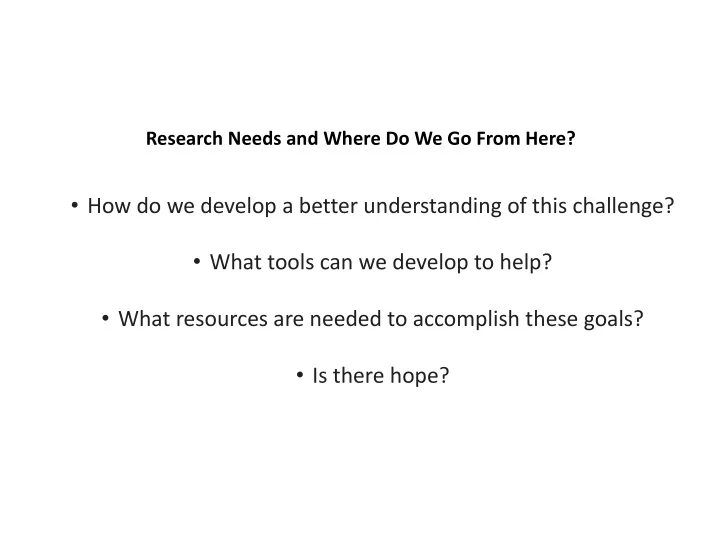

Research Needs and Where Do We Go From Here? • How do we develop a better understanding of this challenge? • What tools can we develop to help? • What resources are needed to accomplish these goals? • Is there hope?
How do we develop a better understanding of ASP in the Gulf of Maine? • Continued interdisciplinary field observations (routine and event response) à increase extent of sampling in space/time and/or pick sentinel sites for focused (and ideally sustainable) sampling http://ifcb-data.whoi.edu/about IFCB >7M images Bar Harbor, since 2006 Februrary 2015
How do we develop a better understanding of ASP in the Gulf of Maine? • Continued interdisciplinary field observations (routine and event response) à increase extent of sampling in space/time and/or pick sentinel sites for focused (and ideally sustainable) sampling • Understand primary drivers related to growth vs. toxin production à what causes a toxic Pseudo-nitzschia bloom? (integrate oceanographic, physiology and life cycle research) West Coast P. australis isolates (McCabe et al. 2016)
How do we develop a better understanding of ASP in the Gulf of Maine? • Continued interdisciplinary field observations (routine and event response) à increase extent of sampling in space/time and/or pick sentinel sites for focused (and ideally sustainable) sampling • Understand primary drivers related to growth vs. toxin production à what causes a toxic Pseudo-nitzschia bloom? (integrate oceanographic, physiology and life cycle research) • Consider local and external factors contributing to changes in community composition à what drives introduction of “new” species? are “new” species really new? how connected are HAB events via known/changing circulation?
What tools can we develop to help? • Evaluate mechanisms of trophic transfer • Rapid screening tools for cells • Discrete sampling (lab-based or in situ) à identify community OR target specie(s) using existing or newly developed primers or probes • Near continuous sampling via instrumentation like the Imaging Flow Cytobot • Rapid screening tools for toxins • Many exist already and some are approved for regulatory screening but are not currently in use in the Gulf of Maine (e.g. Neogen) • Improving extraction protocols to facilitate simultaneous screening of multiple HAB biotoxins • Build conceptual and quantitative models that can help reduce complexity underlying toxicity in the environment • Stronger linkages between events and economic impacts?
Samples DNA extraction Identification LIVE freeze/ thaw single Sequencing w/ chains or cells (4- nested PCR 8/sample) Lugol’s FIXED Other sample types in Concentrated progress: Lugol’s Feces/ FIXED digestive tract Electron microscopy Kit extraction Methods adapted from: Henrichs et al. 2013; Richlen and Barber 2005; Bowers et al. 2016; Hubbard et al. 2008
ECONOMIC AND SOCIOCULTURAL IMPACTS OF THE 2015 WEST COAST DOMOIC ACID EVENT: IDENTIFYING COMMUNITY NEEDS TO HELP FISHING COMMUNITIES COPE Moore et al. 2017, 9 th US HAB Symposium Notable impacts on fishing community 2015 U.S. west coast domoic acid event resulted in fisheries harvest closures that generated an economic shock for • coastal fishing communities (some closures endured > 1 year) 36 community members involved in the fisheries, hospitality, and retail industries, local government officials, • recreational harvesters, and others interviewed to evaluate socioeconomic and cultural impacts Economic hardships extended far beyond fishing-related operations, and permeated through other sectors (like the • hospitality industry). Long-held traditions surrounding crab and shellfish were disrupted, threatening the cultural identities of affected • communities. To minimize these impacts during future events, suggestions from the fishing community included: 1. clearer, more thorough and more rapidly disseminated information regarding fisheries closures and the health risks associated with harmful algal blooms (HABs). 2. financial and employment assistance following HAB-related fisheries harvest closures that is tailored to the unique circumstances of fishing communities.
What resources are needed to accomplish these goals?
Is there hope?
Pseudo-nitzschia species composition varies over decadal time scales
Pseudo-nitzschia species composition also varies over decadal time scales https://eapsweb.mit.edu/news- events/eaps-scope/2013/oceans-ahoy
Pseudo-nitzschia species composition also varies over decadal time scales https://eapsweb.mit.edu/news- events/eaps-scope/2013/oceans-ahoy
Pseudo-nitzschia species composition also varies over decadal time scales https://eapsweb.mit.edu/news- events/eaps-scope/2013/oceans-ahoy
Recommend
More recommend